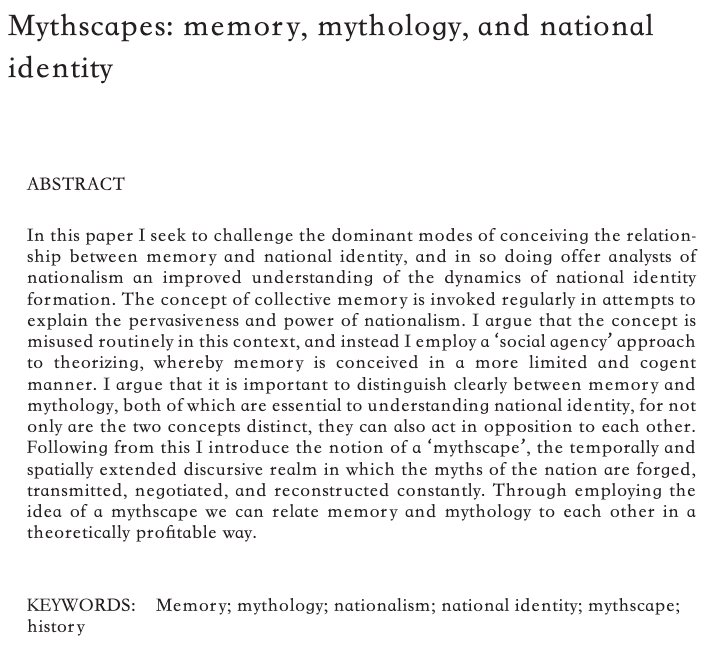WEEK(FLEXIBLE) MYTHSCAPES: MEMORY, MYTHOLOGY, AND NATIONAL IDENTITY

During Flexible Week, I read the thought-provoking article Mythscapes: Memory, Mythology, and National Identity by Duncan S. A. Bell, which examines the intricate relationship between memory, mythology, and the formation of national identity. Bell argues that national identity is not a static or fixed concept; rather, it is continuously shaped by a dynamic process of myth-making—a process he terms the creation of a “mythscape.” This mythscape is a fluid, ever-evolving landscape of myths, memories, and symbols that constitute and reproduce national identity over time.
Bell emphasizes that national myths are not static narratives but dynamic, contested fields of memory that are deeply influenced by power, politics, and cultural shifts. Instead of viewing collective memory as a set of fixed events, he proposes that it is a mythologized interpretation of the past, constantly forged, reinterpreted, and sometimes contested. These mythscapes are embedded in both physical landscapes and cultural representations—such as art, literature, and rituals—serving to link people emotionally to their nation.
Moreover, Bell draws attention to how folklore, historical events, and national symbols are repeatedly reimagined in response to contemporary needs, often during moments of political change or crisis. This ongoing reimagining demonstrates that mythscapes can both unify and divide, affirm tradition or inspire transformation. Ultimately, Bell’s insights offer a powerful framework for understanding how our past continuously shapes our present and future through the stories we tell and remember.
What inspired me?
My exhibition project interweaves Kelpie folklore, canal history and Scottish industry in what is itself a creative act of constructing a mythic landscape. Bell’s framework can help me think about how myths like Kelpie are not just remnants of the past, but live on in cultural memory, adapting to new contexts such as ecological anxieties, industrial heritage and contemporary identity.
I think there are several important points in the article that could enrich my project:
1. Dynamic myths based on local identity
Bell emphasizes that mythic landscapes are tied to the landscape. My choice of Falkirk’s ‘Spiral’ – which is adjacent to the canal, the Kelpies sculpture and the Falkirk Turning Wheel – already touches on symbolic geographies. Combined with this concept, I can design my exhibition as a contemporary mythic space where visitors can navigate the evolving meanings of water, transformation and Scottish identity.
2. Controversy and reinterpretation
The article emphasizes that national myths are often reinterpreted across generations. The works I have chosen – from children’s sculptures (Falkirk 10) to mythic industrial eco-films (Rhadinace) – reflect this view. I could further emphasize that each piece represents a different layer or voice in the mythic landscape, allowing visitors to reflect on how heritage is not singular, but plural.
3. Memory as Collective but Non-Uniform
Bell argues against a monolithic view of national memory. This aligns with my intention to include community participation and storytelling. Consider explicitly incorporating oral histories or local voices into the exhibition, reinforcing that the Kelpie myth—and broader Scottish identity—is continuously shaped by diverse, lived experiences.
References
Bell, Duncan S. A. “Mythscapes: Memory, Mythology, and National Identity.” The British Journal of Sociology 54, no. 1 (2003): 63–81. https://doi.org/10.1080/0007131032000045905.
(https://unsplash.com/photos/brown-pencil-on-white-book-page-fVUl6kzIvLg)




